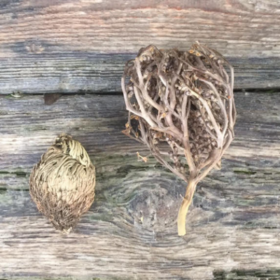ROSE OF JERICHO
The importance in Christianity of the true Rose of Jericho
Christianity, one of the largest religions in the world, includes a wide variety of beliefs and customs. Among these practices, veneration of sacred objects is of significant importance. One such object is the true rose of Jericho, scientifically known as Anastatica hierochuntica. This desert plant was revered among Christians for its symbolic representation of the resurrection and divine grace. In addition, various rituals associated with Christianity are observed across different streams of the faith, which reinforces its rich fabric of traditions.
The true rose of Jericho holds deep symbolism in Christianity, especially in relation to resurrection and resurrection. The plant’s ability to seemingly die and revive itself reflects the narrative of Jesus Messiah’s crucifixion and subsequent resurrection. It is believed that when the plant is dry and lifeless, it can be revived by placing it in water, symbolizing the change from death to life. This process aligns with the core Christian belief in the resurrection of Jesus and the promise of eternal life. As a result, the real Rose of Jericho is often cherished as a physical representation of these spiritual truths, inspiring believers to embrace hope and faith.
Beyond its symbolism, the real rose of Jericho also possesses a captivating beauty that captures the hearts of believers. Its complex structure and the way it unfolds when submerged in water create a sense of wonder and awe. This visual spectacle serves as a reminder of God’s marvelous creation and his power to bring life even in the most challenging circumstances. The true rose of Jericho becomes a physical manifestation of the miracles found in the natural world, and strengthens the belief in a divine presence that controls all things.
Moreover, the ability of the true rose of Jericho to withstand extreme conditions speaks to the resilience and endurance required of Christians in their spiritual journey. Just as the plant survives in harsh desert environments, believers are called to persevere in the face of trials and tribulations. The plant’s ability to revive and flourish despite adversity offers encouragement and inspiration, reminding Christians that through faith and God’s grace, they too can overcome challenges and experience spiritual growth.
The rituals associated with the real Jericho rose vary between different streams of Christianity. In Catholicism, for example, the plant is sometimes integrated into the observance of the Feast of the Epiphany. On the evening of January 6, put the plant in a bowl of water and pray for blessing and protection in the coming year. The water is then distributed among the believers, symbolizing the bestowal of grace and divine renewal.
In Eastern Orthodox Christianity, the real rose of Jericho is used in the sacrament of the anointing of the sick. During this ceremony the plant is dipped in holy oil and used to anoint the forehead of the sick or sick. The anointing symbolizes the healing power of Messiah and the hope for physical and spiritual restoration. The presence of the true rose of Jericho in this ceremony serves as a visible reminder of the transformative and renewing nature of God’s love.
Among Protestant denominations, the use of the true Jericho rose varies. Some congregations incorporate the plant into their Easter Sunday services, emphasizing its resurrection symbolism. The dried plant is placed in a prominent position inside the church, and when the congregation gathers, it is submerged in water, symbolizing the victory of life over death. Other Protestant churches may incorporate the true rose of Jericho into baptismal rites, representing the purification and rebirth experienced through the sacrament.
In addition to its significance in specific ceremonies, the real Jericho rose also has personal and spiritual significance for individual believers. Many Christians keep the plant in their homes as a visible reminder of their faith and hope for resurrection. They may engage in personal rituals, such as praying over the plant or using its water for blessings and protection. The real Rose of Jericho becomes a tangible expression of their devotion, fostering a sense of connection to God and their Christian identity.
The real Jericho rose has great significance in Christianity due to its symbolic representation of the resurrection, divine grace and endurance. This desert plant serves as a visible reminder of the faith’s core beliefs and teachings, inspiring believers to embrace hope, faith and spiritual change. The rituals associated with the actual Rose of Jericho vary among different streams of Christianity, and include practices in Catholicism, Eastern Orthodoxy, and various Protestant denominations. These ceremonies further enrich the diverse tapestry of Christian traditions and strengthen the spiritual connection between believers and their faith. Furthermore, Shoshana Jericho’s captivating beauty and her ability to withstand difficult conditions highlight God’s wonderful creation and serve as a source of encouragement for believers in their spiritual journey. When Christians encounter the true Rose of Jericho, whether through ritual or personal devotion, they are reminded of the deep spiritual truths and promise of resurrection that lie at the heart of their faith.



